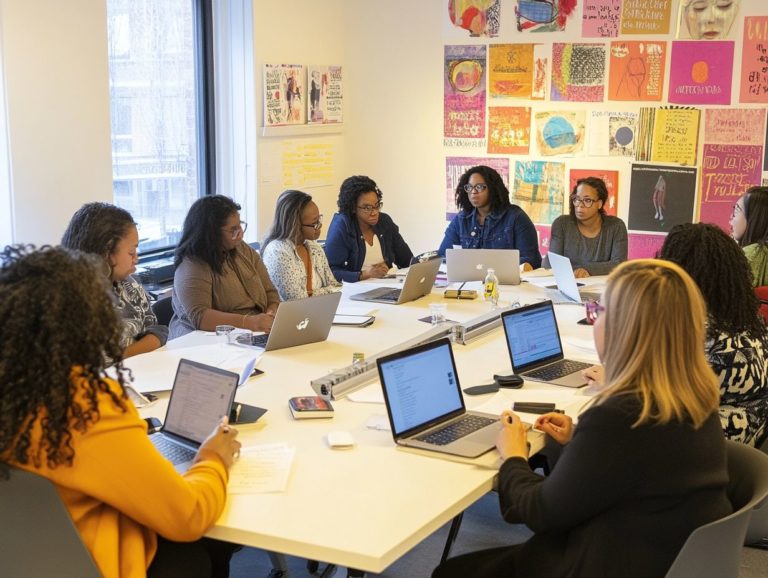How to Build a Skill-Ready Organization
In today s fast-paced business landscape, your success depends on your team’s ability to adapt and grow. This relies heavily on a workforce that is consistently refining its skills.
Building a skill-ready organization is essential for your success! It s not merely a trend; it s a vital strategy for maintaining your competitive edge. This article delves into the significance of skill development, guiding you from identifying the skills your team truly needs to designing effective training programs.
You ll uncover how to foster a culture of continuous learning that empowers employees and boosts overall productivity. Dive in to explore actionable strategies for transforming your organization into a dynamic, skill-focused powerhouse.
Contents
- Key Takeaways:
- The Importance of Building a Skill-Ready Organization
- Identifying the Skills Needed in Your Organization
- Developing a Plan for Skill Development
- Implementing Skill Development Programs
- Measuring the Success of Skill Development
- Creating a Culture of Continuous Learning
- Frequently Asked Questions
- What is a skill-ready organization?
- Why is it important to build a skill-ready organization?
- What are the steps to building a skill-ready organization?
- How can a company identify the skills needed for a skill-ready organization?
- What are some effective training methods for building a skill-ready organization?
- How can building a skill-ready organization benefit employees?
Key Takeaways:

- Investing in skill development is crucial for the success of any organization as it leads to a more knowledgeable and adaptable workforce.
- To build a skill-ready organization, it is important to first assess the current skills of employees and identify any gaps that need to be filled.
- A well-defined plan for skill development, including setting goals and implementing various training and mentoring methods, is essential for achieving success.
The Importance of Building a Skill-Ready Organization
Building a skill-ready organization is crucial in today s competitive business landscape, especially as you aim for heightened employee engagement and enhanced performance. By emphasizing practices focused on skills, you can align your talent management strategies with your broader business objectives.
This approach improves workforce planning, encourages internal movement, and develops critical skills. It ensures that you’re not only addressing current workforce demands but also gearing up for future challenges.
Ultimately, this leads to a more agile and adaptive organization, one that thrives in a rapidly evolving skills economy.
Why Skill Development is Essential for Businesses
Skill development is essential for your business, as it directly impacts employee engagement, how well your business runs, and overall performance.
When you invest in learning and development programs, you’re not just cultivating a motivated and well-rounded workforce; you’re also laying the groundwork for organizational success. Research shows that companies that prioritize these initiatives see profit margins soar by up to 24% and enjoy significantly improved employee retention rates.
For instance, a study by LinkedIn found that 94% of employees would stick around longer if their employer invested in their career development. Skill enhancement is not just about growth; it s crucial for maintaining your competitive edge in today’s rapidly evolving market landscape.
Identifying the Skills Needed in Your Organization
Identifying the skills required within your organization is an essential step in addressing existing skills gaps and aligning your workforce capabilities with strategic objectives.
This deliberate assessment not only enhances operational efficiency but also empowers your team to thrive in a competitive landscape.
Assessing Current Skills and Identifying Gaps
Conducting a thorough skills assessment is essential for identifying any skills gaps within your organization, allowing you to leverage your internal talent effectively.
By utilizing methods such as performance reviews and skills validation techniques, you can gain a comprehensive understanding of your employees’ capabilities. With the help of technology, you can analyze your existing talent pool using data analytics tools which help you understand employee performance through numerical data and performance metrics, which are measurable indicators of how well employees are doing their jobs.
Tools like online assessments or software designed to track employee development can make the evaluation process more transparent, empowering you to make informed decisions on training, promotions, or recruitment strategies. Embracing these strategies not only boosts workforce effectiveness but also fosters a more agile and adaptable organization.
Developing a Plan for Skill Development

When you embark on the journey of skill development, it s essential to craft a comprehensive plan that sets clear goals.
Creating a workforce plan allows you to address both your immediate and long-term skill needs, ensuring you stay ahead in a competitive landscape.
Setting Goals and Creating a Strategy
Clear goals are crucial for your skills development strategy. This alignment between workforce planning and employee development initiatives is vital.
By defining specific, measurable objectives, you can create a structured roadmap that boosts individual capabilities and enhances collective performance.
Assessing existing areas where employees need more training is essential for supporting broader business goals.
Fostering a culture of continuous learning means training and development should be integral to your organization s ethos.
Incorporating feedback mechanisms and adjusting training programs based on real results leads to sustainable skill development, ensuring your workforce evolves with changing market demands.
Implementing Skill Development Programs
Create effective skill development programs to foster a vibrant culture of continuous learning. This ensures employees gain practical experience relevant to their roles, enhancing overall performance.
Training, Mentoring, and Other Methods
Effective training programs and mentoring relationships are essential. They maximize skills utilization and address skills shortages within your organization.
Offering diverse training formats like online courses and interactive workshops caters to various learning preferences, enhancing skill acquisition.
Establishing mentorship initiatives provides invaluable guidance and support, bridging knowledge gaps while fostering professional growth.
Tapping into gig work offers a flexible solution for accessing specialized skills, aligning contributions with business objectives. This approach amplifies internal capabilities and encourages continuous learning.
Measuring the Success of Skill Development
Measuring the success of skill development initiatives is essential for evaluating progress and making necessary adjustments to align with your organizational capabilities and objectives.
Tracking these metrics provides insights to inform your strategy, paving the way for effective and targeted skill enhancement efforts.
Evaluating Progress and Adjusting Plans

Regularly evaluating your progress helps you understand how skill development impacts performance and internal mobility.
Employing various evaluation techniques gives you a comprehensive view of workforce growth. For example, soliciting employee feedback offers insights into existing training programs and reveals areas for improvement.
Performance reviews assess how skill enhancements correlate with job performance and effectiveness.
Conducting a skills metrics analysis provides quantifiable data to identify skill gaps and tailor training initiatives. Reviewing these findings allows you to adjust plans, ensuring they meet individual needs and lead to effective skill development outcomes.
Creating a Culture of Continuous Learning
Cultivating a culture of continuous learning is essential for enhancing employee engagement and facilitating the ongoing development of vital skills within the organization. When you prioritize learning, you empower your team to grow, adapt, and thrive in an ever-evolving landscape.
This commitment supercharges morale and keeps your workforce ahead in the game, ensuring that they are equipped with the expertise necessary to drive success.
Encouraging and Supporting Ongoing Skill Development
In today s temporary job market, encouraging and supporting ongoing skill development is vital. Job roles evolve at a rapid pace, demanding constant adaptation and skill enhancement.
You can create a thriving learning environment by embracing a variety of methods. Offer access to a rich selection of resources, including online courses, books, and webinars. By promoting team learning, members can exchange unique insights and experiences, fostering mutual growth and collaboration.
Implementing reward systems that encourage learning can inspire individuals to actively pursue professional growth. Management plays a critical role in these initiatives. By ensuring that continuous learning remains a priority through appropriate budget allocations and resource support you can help embed a culture of development throughout the organization.
Frequently Asked Questions
What is a skill-ready organization?
A skill-ready organization has the knowledge, abilities, and competencies needed to perform tasks effectively and achieve goals. It focuses on developing employees’ skills to stay competitive and adapt to industry changes.
Why is it important to build a skill-ready organization?

Building a skill-ready organization ensures that employees have the necessary skills to handle challenges and drive success. It also leads to increased productivity, employee satisfaction, and overall organizational growth.
What are the steps to building a skill-ready organization?
The steps include identifying required skills, assessing current skill levels, developing training programs, implementing training, and regularly evaluating and updating skills as needed.
How can a company identify the skills needed for a skill-ready organization?
A company can identify needed skills by conducting a skills gap analysis, evaluating job roles and responsibilities, and seeking input from employees and industry experts. It is also important to consider future trends and changes in the industry.
What are some effective training methods for building a skill-ready organization?
Effective training methods include hands-on learning, job shadowing, online courses, workshops, and mentorship programs. Tailor the training to the specific needs of the organization and its employees.
How can building a skill-ready organization benefit employees?
Building a skill-ready organization benefits employees by providing opportunities for personal and professional growth, increasing job satisfaction and motivation, and preparing them for future career advancement. It also helps employees stay relevant and valuable in the job market.






